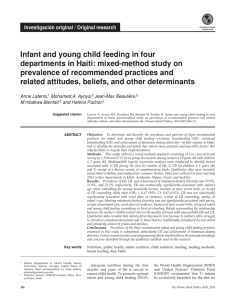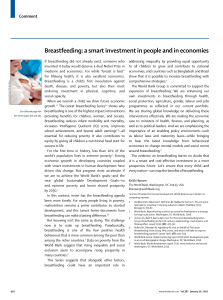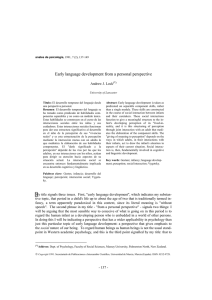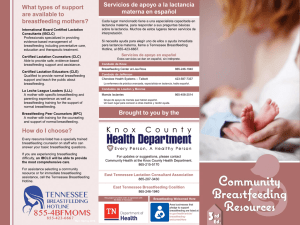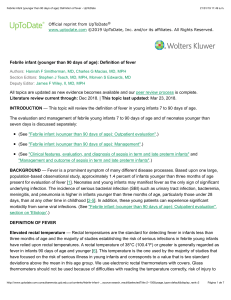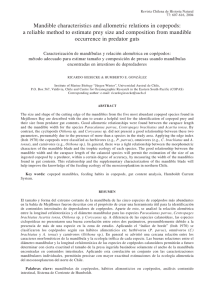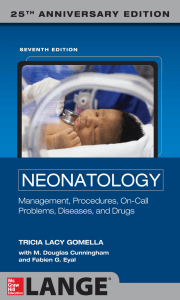Infant feeding practices in the Peruvian Amazon: implications for
Anuncio
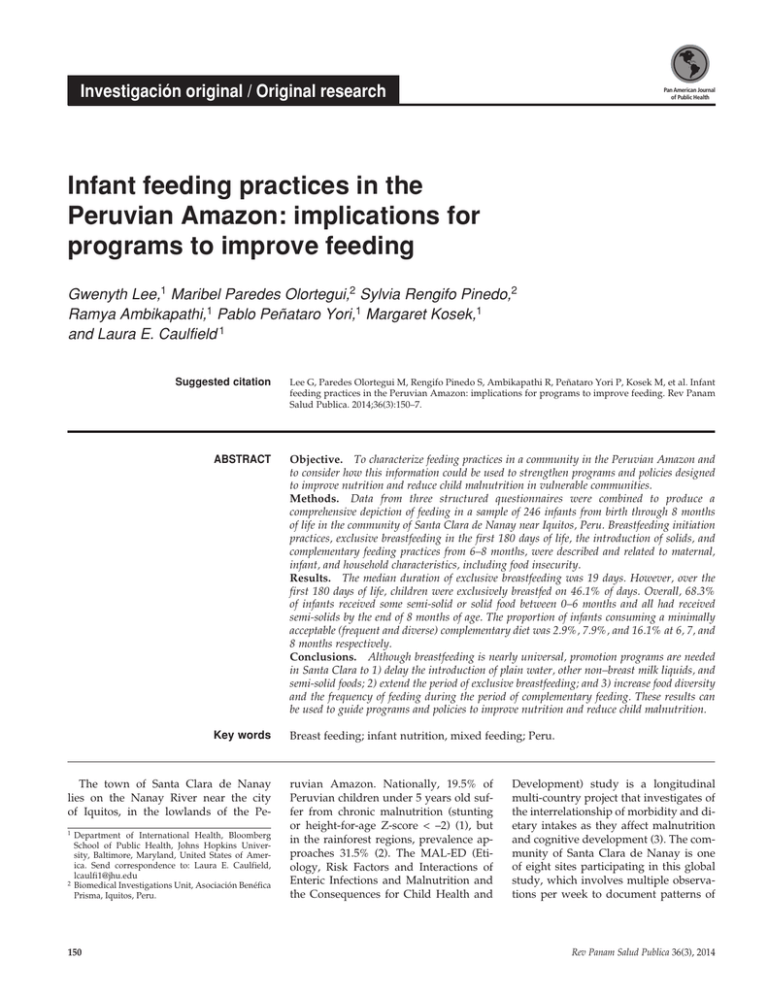
Investigación original / Original research Pan American Journal of Public Health Infant feeding practices in the Peruvian Amazon: implications for programs to improve feeding Gwenyth Lee,1 Maribel Paredes Olortegui,2 Sylvia Rengifo Pinedo,2 Ramya Ambikapathi,1 Pablo Peñataro Yori,1 Margaret Kosek,1 and Laura E. Caulfield 1 Suggested citation Lee G, Paredes Olortegui M, Rengifo Pinedo S, Ambikapathi R, Peñataro Yori P, Kosek M, et al. Infant feeding practices in the Peruvian Amazon: implications for programs to improve feeding. Rev Panam Salud Publica. 2014;36(3):150–7. abstract Objective. To characterize feeding practices in a community in the Peruvian Amazon and to consider how this information could be used to strengthen programs and policies designed to improve nutrition and reduce child malnutrition in vulnerable communities. Methods. Data from three structured questionnaires were combined to produce a comprehensive depiction of feeding in a sample of 246 infants from birth through 8 months of life in the community of Santa Clara de Nanay near Iquitos, Peru. Breastfeeding initiation practices, exclusive breastfeeding in the first 180 days of life, the introduction of solids, and complementary feeding practices from 6–8 months, were described and related to maternal, infant, and household characteristics, including food insecurity. Results. The median duration of exclusive breastfeeding was 19 days. However, over the first 180 days of life, children were exclusively breastfed on 46.1% of days. Overall, 68.3% of infants received some semi-solid or solid food between 0–6 months and all had received semi-solids by the end of 8 months of age. The proportion of infants consuming a minimally acceptable (frequent and diverse) complementary diet was 2.9%, 7.9%, and 16.1% at 6, 7, and 8 months respectively. Conclusions. Although breastfeeding is nearly universal, promotion programs are needed in Santa Clara to 1) delay the introduction of plain water, other non–breast milk liquids, and semi-solid foods; 2) extend the period of exclusive breastfeeding; and 3) increase food diversity and the frequency of feeding during the period of complementary feeding. These results can be used to guide programs and policies to improve nutrition and reduce child malnutrition. Key words Breast feeding; infant nutrition, mixed feeding; Peru. The town of Santa Clara de Nanay lies on the Nanay River near the city of Iquitos, in the lowlands of the Pe1Department of International Health, Bloomberg School of Public Health, Johns Hopkins University, Baltimore, Maryland, United States of America. Send correspondence to: Laura E. Caulfield, [email protected] 2 Biomedical Investigations Unit, Asociación Benéfica Prisma, Iquitos, Peru. 150 ruvian Amazon. Nationally, 19.5% of Peruvian children under 5 years old suffer from chronic malnutrition (stunting or height-for-age Z-score < –2) (1), but in the rainforest regions, prevalence approaches 31.5% (2). The MAL-ED (Etiology, Risk Factors and Interactions of Enteric Infections and Malnutrition and the Consequences for Child Health and Development) study is a longitudinal multi-country project that investigates of the interrelationship of morbidity and dietary intakes as they affect malnutrition and cognitive development (3). The community of Santa Clara de Nanay is one of eight sites participating in this global study, which involves multiple observations per week to document patterns of Rev Panam Salud Publica 36(3), 2014 Lee et al. • Infant feeding practices in the Peruvian Amazon morbidity and infant feeding. Details of the study community have been previously reported (4). While the impact of frequent infections, including enteric pathogens, helminthic infections, and malaria, have previously been described in this setting (5, 6), less is known about the duration of exclusive breastfeeding and the quality of the early infant diet. The research reported here evaluated infant feeding practices among mother– newborn pairs from the time of their enrollment in the study through the infants’ 8th month of life. This included characterizing the period of exclusive breastfeeding, and the timing of introduction and the quality of the early weaning diet. This information could be used to strengthen programs and policies designed to improve nutrition and reduce child malnutrition in vulnerable communities. MATERIALS AND METHODS The MAL-ED project is a prospective cohort study that utilizes a harmonized protocol to recruit, retain, and follow approximately 200 mother–newborn pairs for 24 months at each site. Trained study personnel (eight individuals, primarily nurse technicians) identified pregnant women through a community survey as well as through health clinics or by referral. Inclusion criteria have been described in detail elsewhere (7), but in brief, all healthy singleton newborns weighing more than 1500 g born to mothers 16 years or older and without another participating child were invited to enroll. Infants who could not be followed up for a period of more than 60 days were excluded. Because families in the Santa Clara community travel upriver for extended periods (often for economic reasons), a total of 303 mother–newborn pairs were enrolled initially, with the goal of following 200 pairs through 24 months of age. The rationale for collecting information on infant feeding practices is detailed elsewhere (8). Upon their enrollment in the study, mothers were asked to recall details about breastfeeding initiation and information was collected on maternal characteristics including age, parity, education, and marital status. The study personnel then began visiting the households biweekly to collect data about illnesses since the last visit Rev Panam Salud Publica 36(3), 2014 and infant feeding practices, based on the previous day’s pattern. Each infant’s consumption of breast milk, other (non– breast milk) liquids, and semi-solids was noted. Monthly a third questionnaire, adapted from survey instruments used in the Demographic and Health Surveys (DHS) (9) was administered to study participants to collect information about breastfeeding and the feeding of non– breast milk foods and liquids. Overall, households were visited a median of nine times (interquartile range (IQR): 8, 10) per month. The data collected with the three structured questionnaires were then compiled and analyzed to produce a comprehensive depiction of infant feeding from birth through 8 months of age. In addition, at the infants’ 6th month of age, household socioeconomic data (including monthly per capita income) were collected and food insecurity measured using a Household Food Insecurity Access Scale (HFIAS) adapted by the Food and Nutrition Technical Assistance (FANTA) project for use in low-resource settings (10, 11). Of the 303 infants initially enrolled, information on 246 is presented here (50 were lost to follow-up before reaching the age of 8 months, 1 passed away, and 6 were excluded from the analyses because intermittent gaps in their data amounted to 25% or more of the total period). When the characteristics of the 57 excluded infants were compared to the 246 included in the study, there were no statistically significant differences, although a somewhat higher proportions of males (57.9% versus 55.3%, P = 0.07) and those born at home (14.0% versus 5.3%, P = 0.11) were found among the group that was excluded. A total of 21 564 household visits were completed for the 246 infants during their first 8 months of life. The median time between visits was three days (IQR: 3, 4), with 98.3% of visits occurring within five days of each other. Breastfeeding status was characterized according to standard definitions (12). “Prelacteal feeding” was defined as anything given to the newborn before the first breast milk. Colostrum referred to first breast milk available immediately after childbirth. Exclusive breastfeeding was defined as breastfeeding with no other food or liquid given over the prior 24-hour period, with the exception of drops or syrups consisting of vitamins, Original research mineral supplements, or medicine. If the infant received plain water or waterbased liquids such as tea or juice, it was considered predominant breastfeeding. Full breastfeeding refers to either exclusive or predominant breastfeeding. The inclusion of other milks, formula, and/ or semi-solids was considered partial breastfeeding. In defining the duration of exclusive breastfeeding, the analysis ignored whether or not a prelacteal feeding had occurred to allow for evaluation of whether such practices affected subsequent infant feeding. The proportion of days infants were fed exclusively, predominantly, or partially with breast milk, or had no breast milk, during the first 180 days of life, was calculated following the approach used by Henkle et al. (13). The timing of the introduction of non– breast milk liquids or solid foods was defined as the age (in days) at which the item was first reported, regardless of whether the mother continued to provide it regularly following that visit. The timing of “habitual” introduction to solids was defined as the first age at which solid food was reported, if it was also reported at the next two visits (for a total of three visits or a period of about 10–12 days). From six to eight months of age, the monthly questionnaire was used to quantify the proportion of infants with a diet that met minimal diversity (four or more different food groups, from among those listed in Annex 1) (14). The proportion fed with a minimally acceptable frequency (two or more feedings per day); the proportion with an intake that met minimum standards for both diversity and frequency (minimally acceptable diet) (14, 15); and the proportions consuming vitamin A– or iron-rich foods was also calculated. For the three infants who were no longer breastfed, the study team evaluated the frequency of milk feeding and overall feeding frequency, as recommended by Daelmans et al. (14, 15). Households were categorized as 1) “food secure,” 2) “mildly food insecure,” 3) “moderately food insecure,” or 4) “severely food insecure,” according to the HFIAS classification (10). Data analyses were performed using Stata Statistical Software version 12.1 (StataCorp LP, College Station, Texas, USA). The distributions of variables were characterized by means and stan- 151 Original research dard deviations, or by frequency. Nonnormal distributions were characterized by medians and IQRs. Survival analysis (with age in days) was used to characterize the pattern of decline in exclusive breastfeeding, and estimate the duration of exclusive breastfeeding and full breastfeeding, and the infant did not contribute to the risk set subsequent to their first divergence from the exclusive or full breastfeeding criteria. Multivariate logistic regression models were built to evaluate associations between maternal, infant, and family characteristics and 1) recommended breastfeeding initiation practices (initiation in the first hour, with colostrum and without prelacteal feeds) and 2) greater-than-median time spent exclusively breastfeeding. Models examining the association between the same risk factors and a minimally acceptable diet at 8 months of age were also considered, as were risk factors for early (first quartile: < 152 days) and late (fourth quartile: > 193 days) habitual feeding of solids, compared to those who began receiving solids closer to 180 days (second quartile or 152–181 days and third quartile or 181–193 days) using chi-squared tests and analysis of variance (ANOVA) models. Variables considered included maternal age, education, marital status, parity, home birth, cesarean section, monthly per capita income, and food insecurity. Recommended initiation practices were also considered in relation to the duration of exclusive breastfeeding, and initiation practices and exclusive breastfeeding were considered in relation to the odds of recommended complementary feeding. The protocol was approved by institutional review boards at the collaborating institutions (the Asociación Benéfica Prisma in Lima, Peru, and the Johns Hopkins Bloomberg School of Public Health in Baltimore, Maryland, USA). Written informed consent was obtained from the mother/parent on behalf of the child. Anonymity of the data was maintained by assigning each child a unique personal identification code (PID) by which they were defined in all study materials and in the data (4). RESULTS At study enrollment, the median infant age was four days; 95% of all in- 152 Lee et al. • Infant feeding practices in the Peruvian Amazon fants were enrolled within 14 days of age (range: 1–17 days) (Table 1). Infants weighed about 3 100 g at birth, 10.2% had a low birth weight (< 2 500 g), 55% were male, and 39.3% were first-born. Their mothers were on average 24 years old, married, and had 6–10 years of schooling (22.3% with 0–5 years education, 55.7% with 6–10 years, and 22% with ≥ 11 years). Breastfeeding initiation All infants were breastfed for some period of time. Nearly three-quarters (73.6%) were put to the breast within an hour of birth, and 97.6% initiated breastfeeding within the first 24 hours. A prelacteal feeding was reported for 8.5% of infants, and only 2.2% were not given the colostrum. The odds of following recommended breastfeeding initiation practices were reduced when the child was first-born, born at home, and when the mother was older (Table 2). Exclusive breastfeeding The median duration of exclusive breastfeeding was 19 days (IQR: 8 days, 65 days), but the duration ranged from 0 to 199 days. At 180 days, only four (1.6%) infants were still exclusively breastfed. However, overall during their first 180 days of life, infants were on average exclusively breastfed 46.1% of days (IQR: 15.5%, 72.9%) and fully breastfed 92.8% of days (IQR: 74.0%, 100%). The median duration of full breastfeeding was 146 days. Thus, while other fluids or foods were introduced early, on most days, breast milk was the only source of nutrition. At 180 days, 50.4% of infants were reported to have been fully breastfed on the day prior, 48.4% partially breastfed, and 1.2% as not receiving any breast milk. Figure 1 shows the distribution of breastfeeding status as reported at each visit over the first 8 months of life. Although predominant breastfeeding is reported frequently from the first month of life, the proportion of infants partially breastfeeding does not increase rapidly until the fourth month. Only eight infants were reported as not breastfed during at least one visit in their first 180 days of life. Of these, five reported no breast milk on fewer than four days; two became fully weaned (at 91 days and 142 days); and one infant, whose mother passed away soon after birth, initially received breast milk but was subsequently formula-fed. In addition to the maternal factors associated with poor breastfeeding initiation practices, household food insecurity was negatively associated with the TABLE 1. Selected enrollment characteristics of 246 mother–child pairs, Loreto, Peru, 2009–2013 Characteristic Infant sex: male Mother’s parity 1 2–4 >4 Location of birth Hospital Health center/post Home Cesarean delivery Food insecurityb Food secure Mildly food insecure Moderately food insecure Severely food insecure Mother’s age in years Infant’s median age at enrollment in days (5th, 95th percentiles) Infant’s birth weight in grams Mother’s education in years Per capita income No. (%) or Mean (SDa) 136 (55.3) 95 (38.6) 116 (47.2) 35 (14.2) 208 (84.5) 25 (10.2) 13 (5.3) 23 (9.4) 35 (13.2) 60 (24.4) 85 (34.6) 66 (26.8) 24.4 (6.2) 4 (2, 14) 3 090 (450) 7.9 (3.0) 20.8 (4.8, 71.4)c a SD: standard deviation. As per criteria defined in (10). c One missing value (n = 245); in 2010 US$ (2.80 Peruvian soles = 1 US$). b Rev Panam Salud Publica 36(3), 2014 Lee et al. • Infant feeding practices in the Peruvian Amazon Original research Introduction of liquids and semi-solids TABLE 2. Risk factors for positive and negative dietary, Loreto, Peru, 2009–2013 Recommended initiation practices Crude ORa (95% CIb) Variable Mother’s age Infant first-born Home birth 100 Cesarean delivery Per capita income Exclusively breastfed > 46% of first 180 days 0.93 (0.88, 0.99) 0.41 (0.19, 0.90) 0.25 (0.08, 0.80) 0.48 (0.19, 1.19) 0.75 (0.53, 1.06) 0.025 — — — — — — Percent of cohort Food insecurityc 75 Food secure Mildly food insecure Moderately food insecure 50 Severely food insecure Crude OR (95% CI) P P 0.069 0.114 0.95 (0.90, 1.00) 0.62 (0.31, 1.25) 0.29 (0.08,1.12) — 0.099 — — 0.027 0.020 0.185 0.074 — Reference 0.37 (0.15, 0.95) 0.28 (0.12, 0.68) 0.27 (0.10, 0.67) 0.039 0.005 0.005 a OR: odds ratio. confidence interval. As per criteria defined in (10). b CI: c 25 FIGURE 1. Breastfeeding status of infants from birth through 8 months of age, Loreto, Peru, 0 1 2 3 4 5 6 7 8 9 2009–2013 Age (Months) Exclusive Predominant Partial None 100 Percent of cohort 75 50 25 0 1 2 Exclusive 3 4 5 Age (Months) (months) Predominant likelihood of an infant being exclusively breastfed. When households were classified as mildly, moderately, or severely food insecure, the odds ratios of exclusively breastfeeding for more than Rev Panam Salud Publica 36(3), 2014 6 7 Partial 8 9 None the median number of days were 0.37, 0.28, and 0.27, respectively, compared to infants from the most food secure households (P = 0.039, 0.005, and 0.005, respectively). For 69.4% of infants, water was the first non–breast milk food or drink given; others first received cow’s milk (4.5%), formula (4.5%), tea/coffee (3.7%), or semi-solid foods such as porridge or banana (4.1%). The median age at introduction to water was 30 days; only 10 infants (4.1%) did not receive water during the first 6 months of life and all had received water by the end of 8 months. A total of 37.8%, 28.9%, and 45.1% of the cohort had received animal milks, juice, or tea/coffee respectively at least once during their first 180 days and 83.3%, 87.0%, and 91.5% had received those liquids at least once by 8 months of age (Figure 2). Overall, 68.3% of infants received solid or semi-solid foods before 180 days of age. The median age of first introduction to solid foods was 161 days; the most common solid food reported was porridge (median age of introduction: 170 days). Ninety-nine percent (99.2%), 86.2%, and 95.9% of infants were introduced to potatoes, bananas, and grains by 274 days; fewer infants were introduced to foods such as yogurt or beans (53.7% and 59.3% respectively) (Figure 2). The median age at which solids were habitually introduced to the diet was 181 days (IQR: 152 days, 193 days). Maternal age, parity, monthly per capita income, and maternal marital status were not associated with the age at which semi-solids were habitually introduced. Mothers who introduced solids earliest (< 152 days) or latest (> 193 days) did have on average slightly fewer years of education (< 152 days, 7.3 years maternal education; > 193 days, 7.4 years) than those who introduced solids between 152–181 and 181–193 days (8.8 and 8.0 years respectively) (ANOVA P = 0.002). Children who were habitually introduced to solids after 193 days were more likely to come from families reporting moderate to severe food insecurity than children that were habitually introduced to solids earlier (percentage moderately or severely food insecure versus food secure or mildly food secure = 54.1%, 66.1%, 50.8%, and 74.2% for those introducing solids < 152 days, 152–181 days, 181–193 days, and > 193 days respectively) (chi squared P = 0.028). 153 Original research Lee et al. • Infant feeding practices in the Peruvian Amazon FIGURE 2. Timing of the introduction of non–breast milk liquidsa (top) and solidsb (bottom), Loreto, Peru, 2009–2013 Water Tea/coffee Animal milk Juice 100 Percent of cohort 75 50 25 0 1 2 3 4 5 6 7 8 9 Age (months) Any solids Bean Porridge Banana Rice Yogurt Potato DISCUSSION 100 Percent of cohort 75 50 25 0 1 2 3 4 5 6 7 8 9 Age (months) aLiquids: Water (agua); animal milk (leche animal—enlatada, en polvo, fresca); tea/coffee (té, infusiones); and juice (jugo de frutas). Other liquids (otro líquidos—caldo, milo, kiwigen) were also included in the questionnaire but were reported infrequently. bSolids: Solids, semi-solids, or purees (alimento sólido, semi-sólido, pure); porridges (mazamorra, panes, otros alimentos/ bebidas hechos con trigo, avena, cebada, soya); rice (arroz); potatoes (papas blancas, yuca, otros tubérculos blancos); beans (frijoles, alverjas, lentejas); banana (plátano, guineo); and yogurt (yogurt). Complementary feeding All but one infant was eating solid or semi-solid foods habitually by the end of 8 months of age. However, as shown in Table 3, at 6, 7, and 8 months of age, 47.9%, 17.8%, and 9.0% did not receive complementary foods on the day prior to the interview, and on any given day between 180 and 274 days of age, 10–20% of infants were not fed complementary foods. 154 meat, or egg. Meal frequency was also low, with only 20.3% of infants 6 months old being fed twice or more on the day prior to the interview and only 62.0% by 8 months of age. Combining these two factors revealed that only 2.9% of infants received a minimally acceptable diet at 6 months, rising to 7.9% and 16.1% at 7 and 8 months, respectively. The three infants who were no longer breastfed all received two or more milk feedings and were fed four or more times on the day prior to the interview at 6, 7, and 8 months of age. Iron-rich foods were reportedly given on the day prior to 24%–63% of infants at 6–8 months, but vitamin A–containing fruits and vegetables were only given to 3%–10%. No maternal or child characteristics were significantly associated with the report of a minimally acceptable diet at 8 months. Also shown in Table 3 are the core indicators for assessing the quality of complementary feeding, estimated from the monthly questionnaire. The diversity of foods fed to infants 6–8 months of age was low, with only 5.8%–25.2% having received four or more different food groups on the day prior to the interview. At each month, the most frequently reported diversity was two food groups, with the most frequent combination being grains or roots with dairy products, This is one of the first reports of the early feeding experience of infants living in the Loreto region of the Peruvian Amazon. National surveys of infant feeding have provided a broad overview of the practices overall, and Roche et al. have provided an in-depth picture of infant feeding among the Awajún indigenous people living along the Cenapa River in the neighboring region of Amazonas (16–18), following on much earlier work by Berlin & Markell (19). The current data provide a longitudinal profile of infant feeding in a mestizo community near Iquitos. While not representative, it is likely that the infant feeding practices reported here reflect those of the majority of mestizo communities in the region. The objective of this study was to characterize feeding practices in Santa Clara de Nanay and to consider how this information could be used to strengthen programs and policies designed to improve nutrition and reduce child malnutrition. The WHO recommends that babies be put to the breast within an hour of birth, that they receive colostrum and no prelacteal feeds, and that they be fed only breast milk for the first 6 months of life (20, 21). The current results indicate that initiation of breastfeeding is nearly optimal in this community, with 73.6% of infants put to the breast within an hour, only 8.5% given a prelacteal feed, and only 2.2% that did not receive colostrum. Rev Panam Salud Publica 36(3), 2014 Lee et al. • Infant feeding practices in the Peruvian Amazon Original research TABLE 3. Selected characteristics of the adequacy of complementary feeding in 6–8 month olds, Loreto, Peru, 2009–2013a Child’s age 6 months (n = 242) (%) 7 months (n = 239) (%) 8 months (n = 242) (%) Timely introduction of solid or semi-solid food Dietary diversity (≥ 4 different food groups) Meal frequency (≥ 2 per day) 53.1 5.8 20.3 82.2 14.6 44.8 91.0 25.2 62.0 Minimally acceptable diet 2.9 7.9 16.1 Consumption of iron-rich foods Meats and organ meats Meats, organ meats, fish, eggs, and green leafy vegetables 11.1 24.4 27.6 46.4 38.4 62.8 Consumption of vitamin A–rich foods Yellows fruits and yellow vegetables 3.7 5.9 9.5 Indicator a Three infants who were no longer breastfed were excluded from this analysis. At 8 months, only 1.6% of infants had been fully weaned. Yet the results also demonstrate that only 1.6% of infants were exclusively breast fed to 6 months of age, considerably lower than the estimated national average of 70.6% (22). Methodological differences explain this divergence. Surveys utilize a cross-­ sectional design, obtaining information on the proportion of infants exclusively breastfed on the prior day. Indeed, 50% of study infants at 6 months of age were fully breastfed by this metric. However, when followed longitudinally, as done in the current study, frequent interruptions in exclusive breastfeeding are detected (23). As discussed, the median duration of exclusive breastfeeding was only 19 days, largely because of the introduction of plain water. Often, the feeding of water reflects concerns about hydration. However, well-established literature shows that breast milk alone can sufficiently hydrate an infant even in very hot climates (24). The addition of water can displace breast milk (25) and increase the risk of diarrhea, and subsequently stunting and mortality (26–28). Another threat to exclusive breastfeeding is the introduction of other milk and semi-solid or solid foods during the first 6 months. The median age of introduction is 146 days or about 4–5 months (shown in these results as the duration of full breastfeeding). However, several factors suggest that this early introduction is episodic in nature. First, the proportion of visits in which the child was fully breastfed over the first 6 months was 92.8%, and the median age of regular consumption was 181 days. Second, although not shown, the earlier solids/semi-solids or other milks were Rev Panam Salud Publica 36(3), 2014 introduced the more likely the feeding of these foods was to be sporadic (not a regular part of the infant’s diet). Thus, the early feeding of solids/semi-solids and other (non–breast milk) liquids is frequent but irregular, but at some point at around 5 months of age infants begin to receive these foods regularly. It is also worth noting that 25% of infants only began habitually consuming solids after 193 days of age, much later than recommended. The proportion of infants 6 to 8 months of age that were fed twice or more on the day prior to the interview was low, as was diversity. The proportion of infants consuming a minimally acceptable diet was only 16.1% by 8 months of age. Positively, the proportion of infants consuming iron-rich foods was 62.8% at 8 months. In contrast, vitamin A–rich fruits and vegetables and other fruit and vegetable food groups were infrequently consumed, despite being inexpensive and accessible year-round. No maternal or familiar factors were associated with the likelihood of an 8-month-old infant 1) being fed four or more different food groups, 2) being fed twice or more per day, or 3) being fed a minimally acceptable diet. First-time mothers, those of older age, and those giving birth at home were less likely to report positive breastfeeding initiation and duration practices. These results suggest that efforts to strengthen programs promoting breastfeeding should target these more vulnerable women. Food insecurity was negatively associated with the proportion of days a child was exclusively breastfed and was also associated with a less timely (late) introduction of solids. While few studies have explored associations between food insecurity and exclusive breastfeeding in Latin America, evidence from Southeast Asia and Africa suggests that household food insecurity can affect maternal perceptions of exclusive breastfeeding and infant feeding practices (29, 30), and several studies have found that food insecurity is associated with later introduction of solids (29) or decreased frequency and diversity of complementary feeding (31). Although speculative, food insecurity might lead mothers to leave their infants to seek food for their families or mediate infant feeding practices by acting as a stressor that influences parenting practices (32). Further research is needed to determine whether food insecurity and/or other factors lead(s) to episodic changes away from exclusive breastfeeding in the first 6 months of life. Limitations This study’s main limitation was the lack of information about maternal perceptions and rationales behind feeding decisions. Further research is needed to understand the mothers’ decisionmaking process in order to develop appropriate messages for communication and counseling interventions. Conclusions Breastfeeding initiation practices were nearly optimal in this community. Exclusive breastfeeding was interrupted due to the early introduction of plain water, but the prevalence of full breastfeeding was relatively high. Therefore, reducing the occurrence of early introduction of water should be a priority. Messages to improve complementary feeding should work to improve 1) the timing of the introduction of complementary foods, 2) the consistency of feeding (daily), 3) the frequency of feeding, and 4) the diversity of foods offered. It has been well established that all families should receive guidance on infant feeding as part of preventive health services. The results reported here highlight many positive practices that should be supported as well as areas that need to be targeted and messages that need improved content to safeguard infant well-being in this and similar settings. Acknowledgments. The authors thank the families and children whose gener- 155 Original research ous participation made this study possible. They also thank Matilda Bustos Aricara, Victora Lopez Manuyama, Marla Judith Aricari Huanari, Lleny Amasifuen Llerena, Leoncio del Aguila Amasifuen, Rosario Huansi Torres, Rosario Aricara Macuyama, and Judith Beatriz Chavez Rengifo, for their hard work and thoughtful contributions in the field, and Marvin Emilio Yalta Na- Lee et al. • Infant feeding practices in the Peruvian Amazon varro, Ruth E ­ sther Rodriguez Aquituari, and Ángel Elvis Méndez Acosta, for their involvement in data entry and data management. Funding. The Etiology, Risk Factors and Interactions of Enteric Infections and Malnutrition and the Consequences for Child Health and Development Project (MAL-ED) is carried out as a col- laborative project supported by the Bill & Melinda Gates Foundation, the Foundation for the NIH, and the National Institutes of Health/Fogarty International Center. The authors thank the staff and participants of the MAL-ED Network Project for their important contributions. Conflicts of interest. None. REFERENCES 1.Instituto Nacional de Estadística e Informática (PE). Encuesta Demográfica y de Salud Familiar 2011 [Internet]. Lima: INEI; 2011. Available from: http://proyectos.inei.gob.pe/endes/ 2011/Accessed on 13 September 2014. 2.Instituto Nacional de Estadística e Informática (PE). Encuesta Demográfica y de Salud Fami­ liar—ENDES Continua, 2010, Departamento de Loreto [Internet]. Lima: INEI; 2010. Available from: http://proyectos.inei.gob.pe/ web/biblioineipub/bancopub/Est/Lib1069/ index.html Accessed on 13 September 2014. 3.Lang D. The MAL-ED project: deciphering the relationships among normal gut flora, enteric infection and malnutrition and their association with immune response to vaccines. In: Heidt PJ, Rusch V, Walker RI, editors. Development of strategies to overcome barriers to effective mucosal immunization of infants in developing countries. Herborn-Dill: Old Herborn University Foundation; 2011. Pp. 73–82. 4.Peñataro Yori P, Lee G, Olórtegui MP, Trigoso DR, Flores JT, Vasquez AO, et al. Santa Clara de Nanay: the MAL-ED cohort in Peru. Clin Infect Dis. Forthcoming 2014. 5.Lee G, Yori P, Olortegui MP, Pan W, Caulfield L, Gilman RH, et al. Comparative effects of vivax malaria, fever and diarrhoea on child growth. Int J Epidemiol. 2012;41(2):531–9. 6.Lee G, Pan W, Peñataro Yori P, Paredes Olortegui M, Tilley D, Gregory M, et al. ­ Symptomatic and asymptomatic Campylobacter infections associated with reduced growth in Peruvian children. PLoS Negl Trop Dis. 2013;7(1):e2036. 7.From the MAL-ED Network Investigators. The MAL-ED project: a multinational and multidisciplinary approach to understand the relationship between enteric pathogens, malnutrition, gut physiology, growth, cognitive development and immune responses in infants/children in resource poor environments. Clin Infect Dis. Forthcoming 2014. 8.Caulfield LE, Bose A, Chandyo RK, Nesamvuni C, Lima de Moraes M, Turab A, et al. Infant feeding practices, dietary adequacy and micronutrient status measures in the MAL-ED study. Clin Infect Dis. Forthcoming 2014. 9.ICF International. MEASURE DHS (2010) Survey methodology—survey process [Internet]. Calverton, MD: MEASURE DHS; 2010. Available from: http://dhsprogram.com/WhatWe-Do/Survey-Types/DHS-Questionnaires. cfm Accessed on 13 September 2014. 10. Coates J, Swindale A, Bilinsky P. Household Food Insecurity Access Scale (HFIAS) for 156 measurement of food access: indicator guide (version 3). Washington: Food and Nutrition Technical Assistance Project, Academy for Educational Development; 2007. 11. Psaki S, Bhutta ZA, Ahmed T, Ahmed S, Bessong P, Islam M, et al. Household food access and child malnutrition: results from the eight-country MAL-ED study. Popul Health Metr. 2012;10(1):24. 12. Labbok M, Krasovek K. Toward consistency in breastfeeding definitions. Stud Fam Plann. 1990;21(4):226–30. 13. Henkle E, Steinhoff M, Omer SB, Roy E, Arifeen SE, Raqib R, et al. The effect of exclusive breastfeeding on respiratory illness in young infants in a maternal immunization trial in Bangladesh. Pediatr Infect Dis J. 2013;32(5):431–5. 14. World Health Organization. Indicators for assessing infant and young child feeding practices. Geneva: WHO; 2008. 15. Daelmans B, Dewey K, Arimond M; Working Group on Infant and Young Child Feeding Indicators. New and updated indicators for assessing infant and young child feeding. Food Nutr Bull. 2009;30(2 Suppl):S256–8. 16. Roche ML, Creed-Kanashiro HM, Tuesta I, Kuhnlein H V. Infant and young child feeding in the Peruvian Amazon: the need to promote exclusive breastfeeding and nutrient-dense traditional complementary foods. Matern Child Nutr. 2011;7(3):284–94. 17. Roche ML, Creed-Kanashiro HM, Tuesta I, Kuhnlein HV. Traditional food system provides dietary quality for the Awajún in the Peruvian Amazon. Ecol Food Nutr. 2007;46(5):377–99. 18. Roche ML, Creed-Kanashiro HM, Tuesta I, Kuhnlein HV. Traditional food diversity predicts dietary quality for the Awajún in the Peruvian Amazon. Public Health Nutr. 2008;11(5):457–65. 19. Berlin EA, Markell EK. An assessment of the nutritional and health status of an Aguaruna Jivaro community, Amazonas, Peru. Ecol Food Nutr. 1977;6(2):69–81. 20. World Health Organization. Complementary feeding of young children in developing countries: a review of current scientific knowledge. Geneva: WHO; 1998. 21. Pan American Health Organization. Guiding principles for complementary feeding of the breastfed child. Washington: PAHO; 2003. 22. Instituto Nacional de Estadística e Informá­ tica (PE). Encuesta Demográfica y de Salud Familiar 2011. Lima: INEI; 2011. 23. Ambikapathi R, Kosek M, Olortegui M, Caulfield L. High resolution longitudinal ­ analysis to evaluate the timing, duration and dynamics of exclusive breastfeeding in the Peruvian Amazon. FASEB J. 2014;28(1 Suppl):119–3. 24. World Health Organization. Infant and young child feeding: model chapter for textbooks for medical students and allied health professionals. Geneva: WHO; 2009. 25. Sachdev HP, Krishna J, Satyanarayana L, ­Kumar S. Water supplementation in exclusively breastfed infants during summer in the tropics. Lancet. 1991;337(8747):929–33. 26. Brown KH, Black RE, Lopez de Romaña G, Creed Kanashiro H. Infant-feeding practices and their relationship with diarrheal and other diseases in Huascar (Lima), Peru. Pediatrics. 1989;83(1):31–40. 27. Doak CM, van der Starre RE, van Beusekom I, Campos Ponce M, Vossenaar M, Solomons NW. Earlier introduction of aguitas is associated with higher risk of stunting in infants and toddlers in the Western Highlands of Guatemala. Am J Clin Nutr. 2013;97(3):631–6. 28. Black RE, Allen LH, Bhutta ZA, Caulfield LE, de Onis M, Ezzati M, et al. Maternal and child undernutrition: global and regional exposures and health consequences. Lancet. 2008;371(9608):243–60. 29. Saha KK, Frongillo EA, Alam DS, Arifeen SE, Persson LA, Rasmussen KM. Household food security is associated with infant feeding practices in rural Bangladesh. J Nutr. 2008;138(7):1383–90. 30. Webb-Girard A, Cherobon A, Mbugua S, ­Kamau-Mbuthia E, Amin A, Sellen DW. Food insecurity is associated with attitudes towards exclusive breastfeeding among women in urban Kenya. Matern Child Nutr. 2012;8(2): 199–214. 31. Osei A, Pandey P, Spiro D, Nielson J, Shrestha R, Talukder Z, et al. Household food insecurity and nutritional status of children aged 6 to 23 months in Kailali District of Nepal. Food Nutr Bull. 2014;31(4):483–94. 32. Bronte-Tinkew J, Zaslow M, Capps R, ­Horowitz A, McNamara M. Food insecurity works through depression, parenting, and infant feeding to influence overweight and health in toddlers. J Nutr. 2007;137(9):2160–5. Manuscript received on 18 March 2014. Revised version accepted for publication on 11 August 2014. Rev Panam Salud Publica 36(3), 2014 Lee et al. • Infant feeding practices in the Peruvian Amazon Original research ANNEX 1. Food groups used in evaluating dietary diversity, Loreto, Peru, 2009–2013 Food group Description in structured questionnaire 1. Grains, roots, and tubers “Arroz, avena, pan, fideos, o otra comida hecho de grano” “Papas, yucca, camote morada, sachapapa, pituca, daledale, mandi, huitina, fariña” 2. Legumes and nuts “Comidas hechas con lentejas, frijoles, arvejas, maiz, habas, macambo, maní, castaña” 3. Dairy products (milk, yogurt, and cheese) “Queso, yogurt, o otros lácteos” 4. Flesh foods (meat, fish, poultry and liver/organ meats) “Hígado, riñón, anticucho” “Cualquier carne, como pollo, res, carne de monte, majaz, motelo, pato, cuy” “Pescado (fresco o seco) o churos, tumbacuchara, camarones” 5. Eggs “Huevos” 6. Vitamin A–rich fruits and vegetables “Zanahoria, zapallo, camote amarillo, zapote, sachamango” “Mangos (maduros), papaya, aguaje, pijuayo, taperiba, carambola, cocona” “Verduras de hoja—espinaca, bok choy, acelga, albahca, hoja de nabo” 7. Other fruits and vegetables “Plátano, guineo, manzana, caimito, guaba, guayaba, guanábana, maracuyá, mamey, mandarina, cítricos” “Tomate, palta” resumen Prácticas de alimentación de lactantes en la Amazonia peruana: implicaciones para los programas de mejora de la alimentación Palabras clave Rev Panam Salud Publica 36(3), 2014 Objetivos. Determinar las prácticas de alimentación en una comunidad de la Amazonia peruana y analizar cómo esta información podría usarse para fortalecer los programas y las políticas diseñadas para mejorar la nutrición y reducir la desnutrición infantil en las comunidades vulnerables. Métodos. Se combinaron datos de tres cuestionarios estructurados para obtener una descripción integral de la alimentación en una muestra de 246 lactantes, desde el nacimiento y hasta los 8 meses de vida, en la comunidad de Santa Clara de Nanay cerca de Iquitos, Perú. Se describieron las prácticas de iniciación de la lactancia materna, lactancia materna exclusiva en los 180 primeros días de vida e introducción de alimentos sólidos y las prácticas de alimentación complementaria desde los 6 hasta los 8 meses, y se las relacionó con las características maternas, de los lactantes y los hogares, lo que incluyó la inseguridad alimentaria. Resultados. La mediana de duración de la lactancia materna exclusiva fue 19 días. Sin embargo, en los 180 primeros días de vida los niños habían sido amamantados exclusivamente 46,1% de los días. En términos generales, 68,3% de los lactantes recibieron algún alimento semisólido o sólido entre los 0 y los 6 meses de vida, y hacia el final del octavo mes de vida todos habían recibido alimentos semisólidos. La proporción de lactantes cuyo régimen alimentario complementario había sido mínimamente aceptable (frecuente y diverso) fue 2,9% a los 6 meses, 7,9% a los 7 meses y 16,1% a los 8 meses. Conclusiones. A pesar de que la lactancia materna es prácticamente universal, en Santa Clara son necesarios programas de promoción para 1) retrasar la introducción de agua corriente, otros líquidos fuera de la leche materna y alimentos semisólidos; 2) extender el período de lactancia materna exclusiva, y 3) aumentar la diversidad de los alimentos y la frecuencia de la alimentación durante el período de alimentación complementaria. Estos resultados pueden ser útiles para guiar los programas y las políticas de mejora de la nutrición y reducir la desnutrición infantil. Lactancia materna; nutrición del lactante; alimentación mixta; Perú. 157
